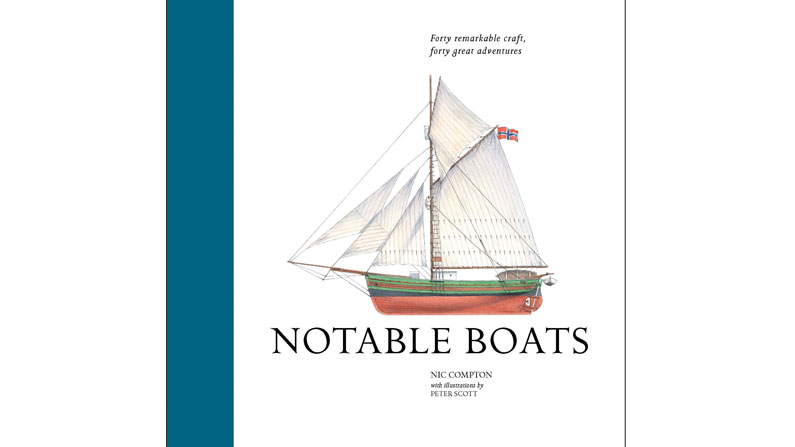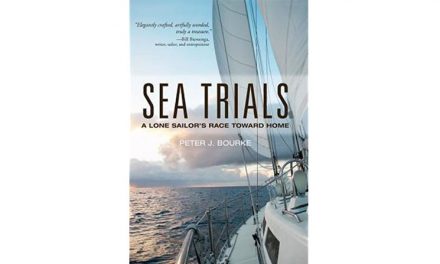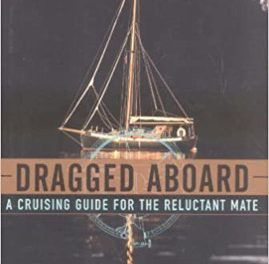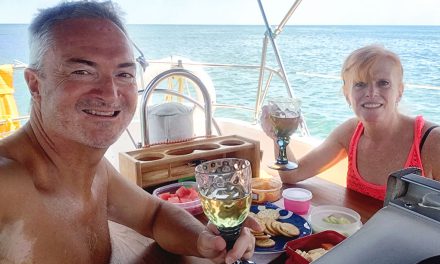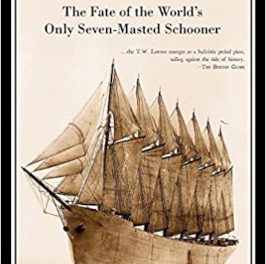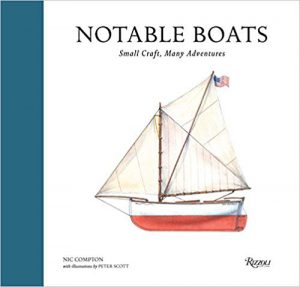 This is an intriguing little book. Although it is titled Notable Boats, it really is the story of some extraordinary people. Compton, who is a past editor of the British magazine, Classic Boats, sets out to profile 36 small boats which he deems to be worthy of note, and his eclectic selection certainly provides interesting reading. The only trait that is common to his choices is that none have engines as their primary propulsion, with the vast majority being propelled by sail. Some, such as Huck Finn’s raft, have no propulsion system at all, and three are propelled by oar alone. The latter include the Tom McClean’s 20-foot dory, Super Silver, which he rowed across the Atlantic in 1969, Jerome K. Jerome’s Pride of the Thames from Three Men in a Boat, and Casanova’s gondola. Indeed, like Huck’s raft, some of Compton’s picks exist only in literature, such as Robinson Crusoe’s periagua. Some that he selects are well known to most sailors, including Joshua Slocomb’s Spray, Robin Knox-Johnson’s Suhaili, the Olin Stephens-designed Dorade, Sir Francis Chichester’s Gypsy Moth IV, Robin Lee Graham’s Dove, and, of course, the schooner yacht America and the iconic Canadian fishing schooner Bluenose.
This is an intriguing little book. Although it is titled Notable Boats, it really is the story of some extraordinary people. Compton, who is a past editor of the British magazine, Classic Boats, sets out to profile 36 small boats which he deems to be worthy of note, and his eclectic selection certainly provides interesting reading. The only trait that is common to his choices is that none have engines as their primary propulsion, with the vast majority being propelled by sail. Some, such as Huck Finn’s raft, have no propulsion system at all, and three are propelled by oar alone. The latter include the Tom McClean’s 20-foot dory, Super Silver, which he rowed across the Atlantic in 1969, Jerome K. Jerome’s Pride of the Thames from Three Men in a Boat, and Casanova’s gondola. Indeed, like Huck’s raft, some of Compton’s picks exist only in literature, such as Robinson Crusoe’s periagua. Some that he selects are well known to most sailors, including Joshua Slocomb’s Spray, Robin Knox-Johnson’s Suhaili, the Olin Stephens-designed Dorade, Sir Francis Chichester’s Gypsy Moth IV, Robin Lee Graham’s Dove, and, of course, the schooner yacht America and the iconic Canadian fishing schooner Bluenose.
The majority of the small boats that Compton profiles have completed some truly remarkable solo ocean voyages, a number of which I was either totally unaware or had only peripheral knowledge. A couple that truly astounded me were the 3,400-mile transatlantic crossing from the Canary Islands to St. Martins in 1956 by the young German doctor Hannes Lindermann in an open folding kayak — a voyage he made to test the bounds of human endurance — and the around-the-world voyage in 1999 to 2003 of Evgeny Gvozdev, in an 11-foot 10-inch boat he built on his balcony in Russia! The amazing thing about both these individuals was that these voyages were the second for each.
Through these often amazing little craft and their incredible voyages, Compton focuses on the men and women who sailed them. If you can argue that every boat has a unique personality, then it is no stretch to claim that in each of these boats that personality perfectly matches, and is even instilled by, that of the owner. Even in the case of Chichester and Gypsy Moth IV, a boat he claimed to hate, both the boat and the sailor are forever fused.
The format of the book is well structured, although the order in which the boats appear in the book seems to be totally random. Each segment opens with a page headed by the boat’s name, with a thumbnail sketch of the boat’s and owners achievements accompanied by a plan view drawing of the boat by John Woodcock listing its principal dimensions. The next page has a full color “sail plan” profile drawing of the boat in color by Peter Scott. Page 3 contains a color map of the voyage by Nick Rowland, along with a description of the achievement extending to all of page 4.
My criticism of this book that purports to focus on notable boats is that the information on the boats themselves is particularly sparse. The chapter on John Lennon’s 1980 voyage to Bermuda in the 42-foot Megan Jaye shows a sail plan drawing that could be a Tartan or Bristol, but the information on the boat does not specify either a builder or designer. The same can be said for Dove and Ellen MacArthur’s 21-foot Iduna, which she sailed around Britain in 1996, as well as Laura Dekker’s Guppy, which she sailed solo around the world as teenager. Each seems to be a fiberglass production sailboat, so I’m not sure why a builder’s designation was omitted.
I would have also liked to know a little more about the illustrators, particularly Peter Scott, who did all the colored sail plan drawings. The name (Sir) Peter Scott is already well known in sailing and ornithological circles. This is obviously a different, but also talented, Peter Scott.
This book is a teaser, giving just enough information to be illuminating, but in a lot of cases left me wanting to know more about some of these incredible boats and people. Fortunately, to satisfy that need, Compton supplies a two page “Further Reading” section at the back of the book. An impulse I had after reading this book was to think of boats that perhaps could also qualify as Notable Boats but that Compton chose not to include. John MacGregor’s Rob Roy sailing canoe, perhaps? Shackleton’s famous Endurance? Any book that leaves you thinking is a book worth reading, and this book does and is. It’s a very worthwhile addition to any sailor’s library. Thank you Mr. Compton.
Notable Boats: Small Craft, Many Adventures by Nic Compton, with Illustrations by Peter Scott (Rizzoli International Publications, Inc., 2017; 160 pages)

